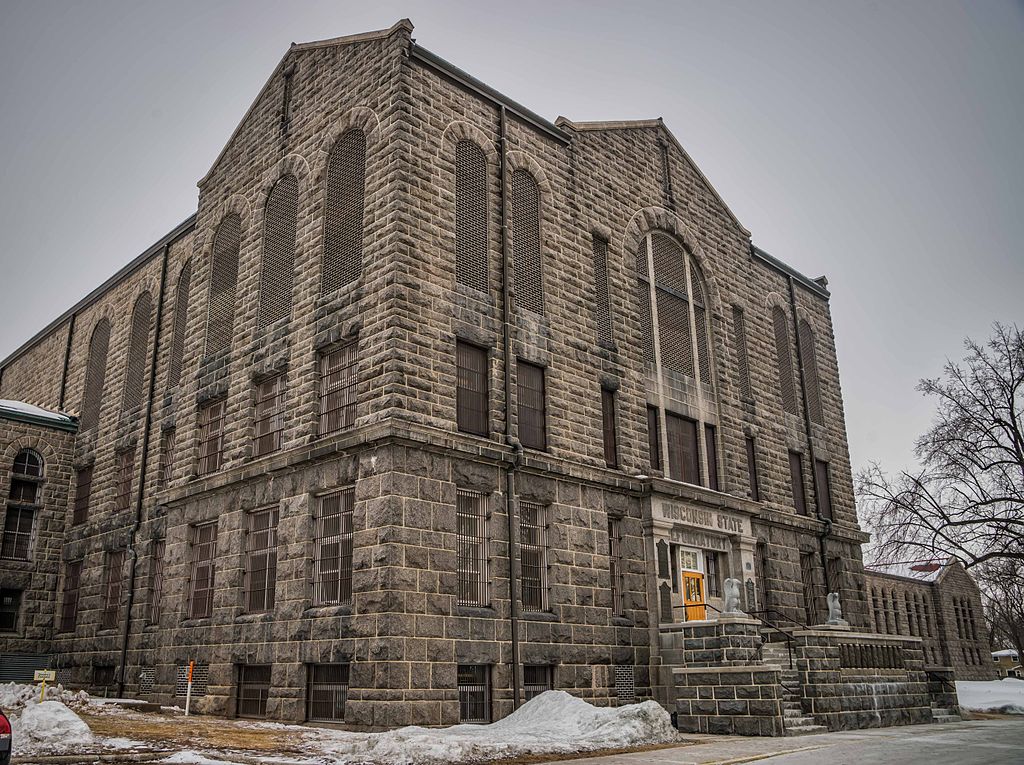When Will Green Bay Prison Be Closed?
Evers and GOP legislators can't agree on when or how or what it will cost.

The Green Bay Correctional Institution in Allouez, built in the 1890s, is Wisconsin’s second-oldest state prison. Rauglothgor/Wikimedia Commons
Now that the Wisconsin budget has called for closing the aging Green Bay Correctional Institution, lawmakers, the governor’s office and the Department of Corrections are having to grapple with how to carry it out.
“For the first time in ever, we finally have agreements in the Legislature and with the executive branch on how to move forward,” said state Rep. David Steffen (R-Howard) after an Allouez village board meeting last week.
There are unresolved details that will need time to work out, Steffen said, but “we’re moving in the right direction.”
Steffen, state Rep. Ben Franklin (R-De Pere) and state Sen. Jamie Wall (D-Green Bay) spoke to the village board Aug. 19 about plans to close the prison, located in the village adjacent to the city of Green Bay. Gov Tony Evers and DOC Secretary Jared Hoy were invited to the meeting but were unable to come, Allouez Village Board President Jim Rafter said.
The 2025-27 Wisconsin budget includes money for preliminary plans to revamp Wisconsin’s prison system and close the Green Bay prison. But what Evers originally proposed and what the document looked like when it reached his desk were far apart.
Pushing for a deadline
Evers originally called for $325 million for a series of projects that would enable the state to close the Green Bay prison in 2029 and transform Waupun Correctional Institution.
What the Legislature passed — largely written by the GOP majority on the powerful Joint Finance Committee — includes $15 million for prison system construction planning related to the corrections department’s realignment, including closing the Green Bay prison.
When he signed the budget July 3, Evers vetoed the 2029 closing deadline, arguing in his veto message that the Legislature had rejected his own plan for closing the prison, which also aimed for closure in 2029. The Legislature, he wrote, provided “virtually no real, meaningful or concrete plan” in place of his.
Republican lawmakers criticized Evers’ veto. In a statement the day that the budget was signed, Steffen said that “only in government would four and a half years be too short of a deadline to finalize the closure of a crumbling building.”
Republican lawmakers want to restore the deadline. Franklin said at last week’s meeting that he will introduce a bill in the fall to set a closing deadline and wants it to be Dec. 31, 2029. The bill should specify that the deadline could only be extended with approval from the Legislature, he said.
Wall gave less weight to the impact of setting a deadline. He pointed to Lincoln Hills, which houses male juvenile offenders. The facility has remained open for years after the original deadline to close it, Wall said, because the Legislature did not take the steps needed to meet that target date.
He also expressed concern that people might leave because of a deadline “that may or may not become real,” exacerbating ongoing staffing problems in the system.
While the shortage of correctional officers improved after pay increased, vacancies have started rising again. The DOC and prisons across the country have experienced staffing troubles, which can lead to more restrictive conditions for incarcerated people.
Vacancy rates published by the DOC for correctional officers and sergeant positions in adult prisons climbed to 35% in August 2023. The vacancy rate declined to about 11% in fall 2024, but it has since increased to 17%. At Green Bay and Waupun, it’s over 25%.
“Historically speaking, from the time that I started there to the time that I left… if 10 new people would start at one point, usually half would quit,” former Green Bay corrections officer Jeff Hoffman told the Examiner last year. “Because they didn’t want to work in that environment.”
Differences over prison system planning
Franklin said his proposed deadline bill will more specifically state how the $15 million will be spent.
Wall said the DOC is already developing a plan for spending the money, which will go through the state building commission. The plan is to direct the money to the kind of facility changes that Evers proposed originally, he said.
Franklin said Republicans will have to be flexible in adopting some of Evers’ proposals to restructure juvenile centers and medium and maximum security adult prisons. He said he doesn’t think everything will be adopted as Evers originally proposed, however.
Franklin said he also wants to set milestone dates, for actions such as transfers of incarcerated people, which would provide “a barometer of where we’re at” ahead of the closing deadline.
He said he also wants quarterly progress reports to the Joint Finance Committee.
Steffen said the committee and the Legislature should have the opportunity to see and understand plans and ask questions more than once and have time to deal thoughtfully with the situation instead of “in a pressure cooker budget environment.”
Wall cautioned against moving too slowly, however. DOC has some projects that could go up for approval early in 2026, he said.
“And time is not necessarily on our side here when it comes to the state budget,” Wall said, noting that if the economy softens, that could affect the state budget.
According to the Wisconsin Policy Forum, the state could be facing a more difficult budget in 2027 than it has seen in recent years, with recently approved spending and tax cuts using up most of the surplus.
Speaking to reporters after the Allouez meeting, Steffen said that “we are generally in agreement on what to do with the buildings, the expansions at the other facilities and the closure” at Green Bay.
But he said there will be incarcerated people who need somewhere to go. Republicans and Democrats differ on whether to expand the earned release program — releasing some people before their sentence is completed — or “find the space within the system” to move them, Steffen said. He raised the possibility of having local jails take in prisoners, a tactic the Department of Corrections has used to reduce overcrowding.
Funding remains uncertain, Steffen added.
Aging prison system
A 2020 draft report on the Department of Corrections’ website includes information about problems created by the infrastructure inside the aging prisons in Green Bay and Waupun.
“There are a lot of issues with running facilities that are that old,” Hoy said in April about the Green Bay facility. “We shouldn’t be running prisons in that manner in 2025… We want to do more with our population than what those facilities can afford us to do.”
Prison reform advocates hold vigils outside the prison. Wisconsin Department of Corrections data shows that on average, prisoners at GBCI spend an average of 48.5 days in disciplinary separation, where an incarcerated person may be sent for committing a violation — the most of any prison listed.
While lawmakers push to close the Green Bay prison, it’s unclear what will become of Waupun, the state’s oldest prison, which has attracted scrutiny for a string of prisoner deaths, a lockdown and living conditions.
The governor’s proposal in February aimed to close the prison temporarily and convert it to a medium-security institution and “vocational village” emphasizing job training and readiness at an estimated cost of $245.3 million. The provision did not pass the Legislature.
While Allouez’s Rafter wants to close the Green Bay prison, Waupun mayor Rohn Bishop has called for keeping Waupun Correctional Institution open.
Bishop has pointed to the economic impact on Waupun and to the city’s history and heritage. In a column in December, he said the city donated the land to bring the prison there, generations of people in Waupun have worked at the prison and local churches have had outreach to incarcerated people.
With Green Bay prison marked for closing, state officials now must figure out how and when was originally published by Wisconsin Examiner.
If you think stories like this are important, become a member of Urban Milwaukee and help support real, independent journalism. Plus you get some cool added benefits.




















